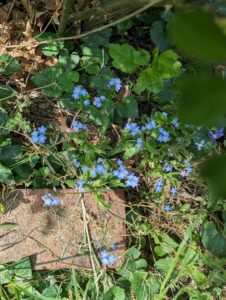
 Early spring is usually the time for the little flowers, like snowdrops, winter aconite and crocus. Though their stature is small, they emerge from the winter-drab earth in flashes of color. After a few weeks they give way to the flashier daffodils and tulips, which in turn bow out in favor of peonies and roses, true divas of the late spring garden.
Early spring is usually the time for the little flowers, like snowdrops, winter aconite and crocus. Though their stature is small, they emerge from the winter-drab earth in flashes of color. After a few weeks they give way to the flashier daffodils and tulips, which in turn bow out in favor of peonies and roses, true divas of the late spring garden.
But in the midst of the current unfurling of those big, brilliant plants, forget-me-nots manage to pop up and command attention. Why? Probably because of their startling, true-blue flowers.
Lots of plants boast blooms in shades of blue leavened with greater or lesser quantities of purple. Far fewer genera and species leave the purple behind and shine in clear blue tones. Some of the most prominent blue-flowered species are members of the borage or Boraginaceae family. Forget-me-nots, which are known botanically as myosotis, are part of that clan. Their borage relatives include false forget-me-nots or Brunnera, fabled for their lovely variegated leaves, as well as vibrant blue flowers. Mertensia or Virginia bluebells are also borages, as are low-growing pulmonaria or lungwort.
In my garden, a little patch of pink forget-me-nots is currently holding court at the feet of a large Chinese tree peony that has just finished a rather spectacular period of bloom. I think of the forget-me-nots as palate cleansers in the feast of spring bloom. The little patches of blue are also coming up in the flowery mead of the back garden, challenging the various violets, ajuga and bluebells for mid-spring supremacy. Most of the forget-me-not clumps in the back feature blue flowers, but a few are pink—just enough for a nice contrast.
Most of us think of common forget-me-nots or Myosotis syvatica as native wildflowers. They are certainly wild in their habits—spreading freely and jumping boundaries at will—but they are not native. Like the vast majority of North Americans, they emigrated from other places. Myosotis sylvatica is native to temperate zones in Europe and parts of Asia. The seeds probably arrived early, either brought deliberately by settlers, or hitchhiking on boots, clothing or packing materials. They took to the wide open spaces with wild abandon.
If you look closely at a cluster of common forget-me-not flowers, you will see that each one has five petals, fused into a short basal tube. The leaves are oblong and tend to be covered with soft hairs. Technically they are biennial, meaning that the plants form rosettes of leaves in the first year after planting and bloom the second year. Sometimes forget-me-nots may be short-lived perennials, but at all times, self-seeding makes them effectively perennial. The plants favor lightly shaded locations on the edges of garden borders, lawns, woodlands, or unused patches of ground. In gardens they may be somewhat unpredictable, producing masses of plants in one year and fewer clumps the next year, depending on weather conditions and other variables. In bumper years, they will almost certainly show up in unexpected places. I think it is hard-hearted to grub out the unexpected forget-me-nots, but if you feel differently, they are easy to uproot.
Breeders have paid some attention to forget-me-nots, but have hardly lavished the kind of devotion given to other species like coreopsis or coneflowers. Still, if you are looking for “improved” varieties, you can try either ‘Victoria Blue’ or ‘Victoria Pink’. I have never seen ‘Mon Ami Blue’, which sounds very French and sophisticated, but it is reputedly a bit more pale in color than other sylvaticas. ‘Snowsylva’ is a refreshing white variety.
For gardeners with damp spaces and a fondness for forget-me-nots, try the rather sinister sounding Myosotis scorpioides or water forget-me-not. The name refers to the coiled shape of the unopened flower stalks, but the flowers are the typical forget-me-not type in an eye-catching shade of sky blue. The leaves are a brighter green than those of the sylvestris species. Like the common variety, water forget-me-nots have also broken free of domestic situations and populated wilder areas.
If your neighbors have forget-me-nots on their properties, you will probably acquire some in the course of natural events. If not, try ordering from Plant Detectives, 45 Route 206, Chester, NJ 07930; (908) 879-6577; www.plantdetectives.com.
